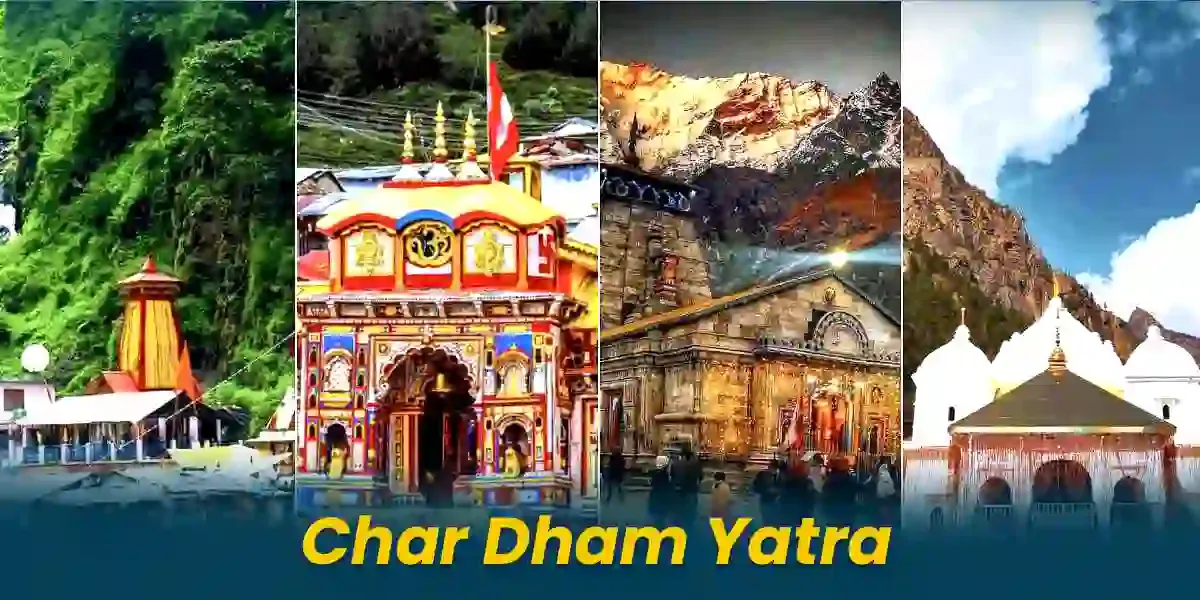
Are you still wondering how to plan your Char Dham Yatra or how it can change your life? Char Dham (four abodes) are situated in the Himalayas, which are believed to offer Moksha (salvation) to devotees.
Yamunotri marks the beginning of our journey, where the Prasad is given in the form of a small rice bag dipped in the hot spring water. Next, we head towards Gangotri Dham, where we take blessings of the Goddess Ganga and carry Ganges water to Kedarnath Dham, where we offer water to Shiv Linga and receive Bhasma as Prasad. Finally, the Char Dham Yatra ends at Badrinath Dham, where Prasad is taken as Tulsi Mala.
Let’s walk through the Himalayas to know more about the Char Dham.
Begin Your Spiritual Journey With Char Dham Yatra
Let’s take a dive into the valley of devotion and discover the sacred path through Char Dham Yatra, Yamunotri, Gangotri, Kedarnath, and Badrinath
Yamunotri
The 1st Char Dham name is Yamunotri. Situated in Uttarakhand, it is considered the starting point of the Char Dham Yatra. Yamunotri is the source of the holy river Yamuna.
- The River of Salvation
Goddess Yamuna is the daughter of Lord Sun and sister of Lord Yama. On the auspicious day of Bhai Dooj, Yamuna called Yamraj for lunch, and in return, Yamraj gave her a boon that people who take a dip in the holy water of Yamuna won’t have to face Yamdut (messenger of Yama - the God of death) and attain Moksha (salvation).
- Suryakund
It’s a holy thermal spring surrounded by snow-capped peaks. Pilgrims prepare Prasad with rice or potatoes mixed with salt and tie it in a muslin cloth, and then dip it into the hot spring, boil it, and offer it in the temple.
- Yamunotri Temple
The sacred temple is dedicated to the Goddess Yamuna. The idol of Yamuna stands inside the temple, which is made of black marble. Devotees worship the Goddess Yamuna and seek blessings to complete their Char Dham Yatra with ease.
Gangotri
One of the Char Dham in India is Gangotri, which is dedicated to the Goddess Ganga, who flows in the form of divine knowledge throughout India. Gangotri is one of the most sacred pilgrimage sites in Uttarakhand, situated amidst the Himalayan peaks and dense forests.
- Bhagirathi (Ganga From Heaven)
According to the scriptures, the Holy Ganga initially flew solely into heaven as Aakash Ganga (Sky River or Milky Way). King Bhagirath performed rigorous penance to bring the Goddess Ganga to flow on Earth, as he wanted his 60 thousand ancestors to attain Moksha. Since Ganga’s descent was extremely powerful, it could have destroyed the Earth, so Lord Shiva placed the holy river Ganga in his hair and smoothly released her to flow on Earth. Since it was Bhagirath who brought Goddess Ganga to Earth, she’s also known as Bhagirathi.
- Gaumukh (Origin of the River Ganges)
Situated 19 km from Gangotri temple, Gaumukh (Cow’s face) is a holy destination, the origin of the river Ganga, which is known as Bhagirathi here. She appears out of a cave-like formation that resembles a Cow’s face. At Devprayag, Bhagirathi meets the holy river Alaknanda, and together they form the sacred river Ganga.
- Gangotri Temple
Devotees carry water from the Gangotri to Kedarnath and offer it to Lord Shiva with an emotion to provide him some relief from the poison he drank during Samundra Manthan (Churning of the Ocean). A temple dedicated to the Goddess Ganga can be seen here, where devotees offer their utmost devotion to the goddess.
Kedarnath Dham
Kedarnath Dham, situated at the head of the holy river Mandakini, is dedicated to Lord Shiva. It’s not just one of the Char Dham but one of the 12 Jyotirlingas. Adi Shankaracharya, a saint who is considered an incarnation of Lord Shiva, performed rigorous penance here and enshrined the Shiva Linga. The temple remains closed from October to April due to the heavy snowfall.
- Gaurikund (Journey to Lord Shiva Begins)
Kedarnath Dham Yatra begins at Gauri Kund, where Goddess Parvati performed intense Tapasya (penance) to get Lord Shiva as her husband. Seeing her unconditional love, Lord Shiva appeared and agreed to marry Goddess Parvati. Devotees take a dip in the nearby Tapta Kund, which is known for its healing properties, and seek the blessings of Parvati to begin their journey and reach Lord Shiva.
- Kedarnath Temple
This sacred site is mysteriously beautiful; the fresh, cold breeze carries a sense of divinity, arousing the realization that we belong to the supreme lord. The Kedarnath Valley is protected by Lord Bhairav. The Shiva Linga in Kedarnath temple is unique, it looks like the hump of a bull. As we move into the temple, Nandi’s idol can be seen along with the idols of Shree Krishna and Veer Bhadra.
- Bhim Shila
Bhim Shila is a massive stone or rock near the Kedarnath temple, which the devotees worship. It saved the Kedarnath temple from flood and landslide in 2013. When everything was being washed away, this stone stood as a blessing that not even the huge mountains could move.
- Pandavas in Dwapar Yug
According to a legend, the Pandavas felt guilty after killing the Kauravas, so they wanted to repent for their Karma. Lord Krishna advised them to pray to their Ishta Dev (personal deity). Walking through the Gauri Kund, the Pandavas saw a black bull and a black dog. Bheem realized that it was none other than Lord Shiva and Lord Bhairav in bull and dog forms, and Lord Shiva was their Ishta Dev. The Pandavas began chasing the bull to reach Kedarnath, and here the bull vanished into the ground, leaving its hump above, which can still be seen in the temple as a Shiva Linga.
You may also like to read: 5 Shakti Peethas You Must Visit Once in Life!
Badrinath Dham
The Badrinath temple, also known as Badri Vishal, is one of the Char Dham situated in the Garhwal Himalayas in Uttarakhand. The sacred temple dates back to the 8th century when the idol of Lord Vishnu was discovered in Narad Kund and re-established by Sage Adi Shankaracharya, who is believed to be an incarnation of Lord Shiva. According to a legend, Lord Vishnu meditated here for thousands of years and continues to meditate to this day.
- Panch Prayag (Confluence of Rivers)
On your way to the divine meet, you will encounter 5 Sangams (union of the holy rivers), which add peace to your life.
Devprayag - The union of the rivers Alaknanda and Bhagirathi
Rudraprayag - The meeting point of the rivers Alaknanda and Mandakini
Karnaprayag - The union of the rivers Alaknanda and Pindar
Nandprayag - The confluence of the rivers Alaknanda and Nandakini
Vishnuprayag - The union of Alaknanda and Dhauliganga
- Badrinath Temple
Lord Badri Narayan holds the Chakra (divine disc) and the Conch in his two hands in a lifted posture, while the other two hands rest in a Yogic Pose. It is believed that people who visit Lord Badrinath at least once in their lifetime won’t have to come into this mortal world again, hence attaining Moksha (salvation).
Summary
Char Dham Yatra purifies individuals and washes off their sins. It makes people realize that there’s a higher purpose in life apart from materialistic gains, which is to love and surrender to the divine.
There are some spiritual practices that you can perform at Char Dham that will bring peace, prosperity, and luck to your life. Know the personalized and accurate remedies or practices according to your horoscope by an astrologer on Astroyogi. Consult now!
Our in-house team of writers comprises of vibrant, like-minded, and curious souls who are passionate about helping people find joy and motivation through the magic of words. Our writers are keen on using their skills to make the study of divination sciences a guiding tool in people's lives. They hold expertise in writing on a myriad of topics related to Indian Astrology, Spirituality, Planetary Movements, Vastu Shastra, Numerology, and Tarot among several others. The Astroyogi team aims to write articles that can help the readers lead a life of peace and tranquility whilst enjoying the many ups and downs of life!






































